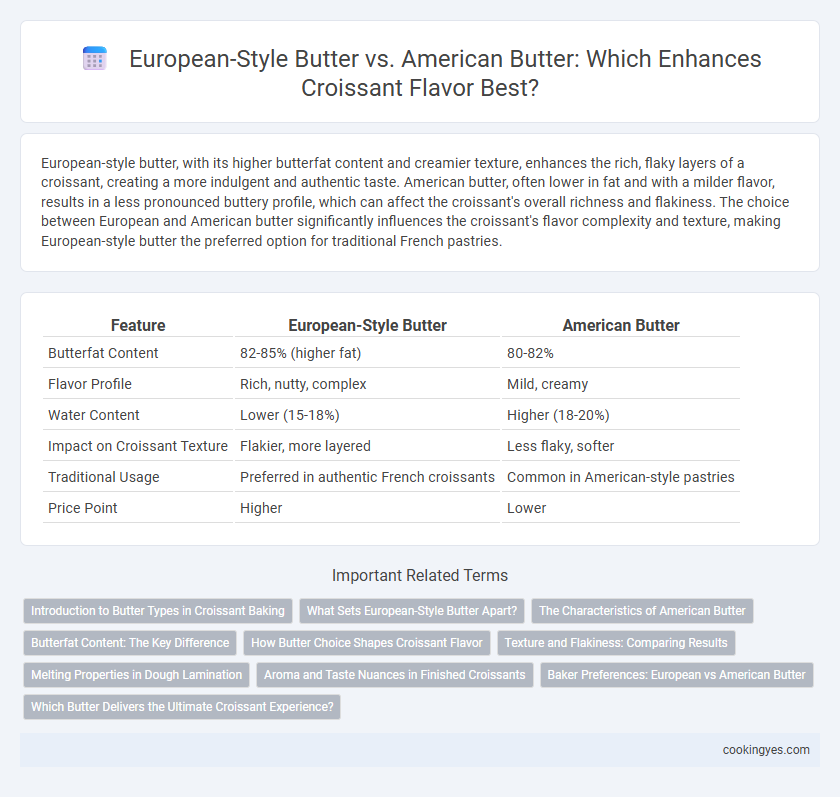European-style butter, with its higher butterfat content and creamier texture, enhances the rich, flaky layers of a croissant, creating a more indulgent and authentic taste. American butter, often lower in fat and with a milder flavor, results in a less pronounced buttery profile, which can affect the croissant's overall richness and flakiness. The choice between European and American butter significantly influences the croissant's flavor complexity and texture, making European-style butter the preferred option for traditional French pastries.
Table of Comparison
| Feature | European-Style Butter | American Butter |
|---|---|---|
| Butterfat Content | 82-85% (higher fat) | 80-82% |
| Flavor Profile | Rich, nutty, complex | Mild, creamy |
| Water Content | Lower (15-18%) | Higher (18-20%) |
| Impact on Croissant Texture | Flakier, more layered | Less flaky, softer |
| Traditional Usage | Preferred in authentic French croissants | Common in American-style pastries |
| Price Point | Higher | Lower |
Introduction to Butter Types in Croissant Baking
European-style butter has a higher butterfat content, typically around 82-85%, which contributes to the rich, flaky texture and deep flavor of croissants. American butter usually contains 80-81% butterfat and has a higher moisture content that can affect dough elasticity and final crispness. Choosing European-style butter in croissant baking enhances the buttery aroma and creates the characteristic layers essential for authentic texture and taste.
What Sets European-Style Butter Apart?
European-style butter distinguishes itself from American butter through its higher butterfat content, typically ranging from 82% to 86%, compared to the American standard of around 80%. This increased fat concentration contributes to a richer, creamier texture and enhances the flaky, tender layers crucial to an authentic croissant. Additionally, European butters often undergo a longer aging process, which develops complex, nutty flavor notes that elevate the croissant's taste profile significantly.
The Characteristics of American Butter
American butter typically contains about 80% milk fat with a higher moisture content around 16-18%, which can result in a softer texture when baked in croissants. Its slightly sweeter and less intense flavor compared to European-style butter affects the final taste profile, often producing a milder buttery note rather than a rich, creamy depth. The lower fat content and increased water can also impact the lamination process, potentially leading to less flakiness and a more tender crumb in the croissant.
Butterfat Content: The Key Difference
European-style butter typically contains 82-85% butterfat, significantly higher than American butter which averages around 80%. This elevated butterfat content enhances the croissant's flakiness and imparts a richer, creamier flavor profile. The higher moisture content in American butter can also result in a less tender crumb and diminished buttery taste.
How Butter Choice Shapes Croissant Flavor
European-style butter, with its higher fat content (82-85%) and lower water percentage, creates a richer and flakier croissant texture due to enhanced lamination. American butter typically contains around 80% fat, making croissants slightly less tender and flavorful but still buttery. The choice of butter directly influences croissant aroma, mouthfeel, and overall taste, with European butter providing a deeper, creamier flavor profile essential for authentic French pastries.
Texture and Flakiness: Comparing Results
European-style butter, with its higher fat content (around 82-85%) and lower water percentage, enhances croissant texture by producing a richer, flakier crumb and delicate layers. American butter typically contains less fat (about 80%) and more water, which can result in slightly denser pastries with less pronounced flakiness. The elevated fat concentration in European butter improves lamination, yielding superior lift and crispness in traditional croissants.
Melting Properties in Dough Lamination
European-style butter, with its higher fat content of around 82-85%, offers superior melting properties essential for dough lamination in croissant making, producing a flakier and more tender texture. American butter typically contains lower fat percentages (around 80%) and higher water content, which can cause uneven melting and steaming during baking, reducing the delicate layers characteristic of a quality croissant. The consistent melting point of European butter ensures precise lamination, resulting in the signature airy and buttery layers of classic European croissants.
Aroma and Taste Nuances in Finished Croissants
European-style butter, with its higher fat content of around 82-85% and rich, cultured aroma, imparts a deep, creamy flavor and pronounced butteriness to croissants. American butter, typically containing about 80% fat and a milder, sweeter taste, results in a subtler flavor profile with less aromatic complexity. The nuanced, tangy notes from European-style butter enhance the flaky layers, delivering a more authentic and indulgent croissant experience.
Baker Preferences: European vs American Butter
Bakers often prefer European-style butter for croissants due to its higher fat content, typically around 82-85%, which contributes to a richer, flakier texture and enhanced flavor. American butter, with a lower fat percentage averaging 80%, tends to have a milder taste and higher water content, which can affect the lamination process and result in less distinct layers. The choice between European and American butter significantly influences the croissant's buttery aroma and delicate crumb preferred by artisan bakers aiming for authentic French quality.
Which Butter Delivers the Ultimate Croissant Experience?
European-style butter with its higher fat content (82-85%) and lower water percentage enhances croissant layers, yielding a richer, flakier texture compared to American butter, which typically contains around 80% fat. The cultured, slightly tangy flavor of European butter intensifies the buttery aroma and depth, crucial for an authentic French croissant experience. Bakers seeking the ultimate croissant flavor prioritize European butter to achieve superior dough elasticity and a pronounced, creamy taste that American butter often lacks.
European-style butter vs American butter for croissant flavor Infographic

 cookingyes.com
cookingyes.com